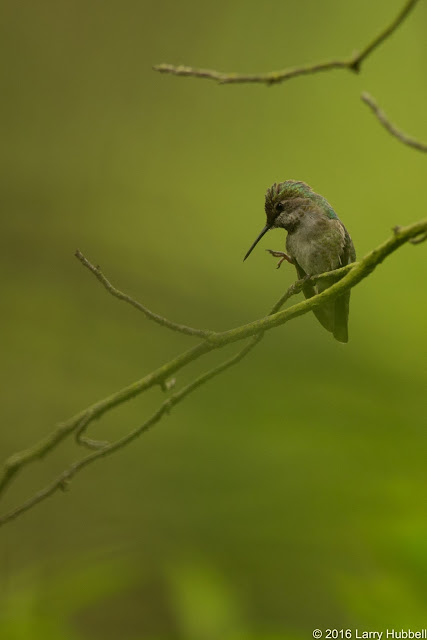Its almost like she wears it. I can imagine she slips it over her head. A sweater made of moss 'n lichen - discreetly stitched with spider silk.
At the right angle, her iridescent feathers bloom into a rosy glow.
They do not hold a candle to the male's head dress. The female seeks solace in substance, rather than style.
She builds the nest, lays the eggs, protects and feeds the young and all the while working virtually non-stop. Who can blame a female if she occasionally needs to get away for a little "me-time". (Males seem to sit around and look pretty, until its time for a battle of egos.)
Stretching the neck seems like a good start. She looks up...
...and then she looks down - most likely with a cleansing breath.
She stretches the right foot...
...and then thoughtfully scratches her chin.
Then, she switches feet to do it again.
She even stretches her tongue. I have often wondered why a hummingbird will extend its tongue into the empty air. My first thought is, it must be similar to when we lick our lips - maybe a cleaning maneuver. I am curious whether they might be able to taste pollen in the air.
Then she does the classical wing & tail stretch.
This is followed by checking under her wing...
...and then an in-depth probing of ruffled feathers.
Surprisingly, her wings can be stretched down as well as up.
Next, we are treated to the full feather fluff.
This is followed by a ten feathered fan of the tail...
...and the don't-be-laughing-at-me look.
Ultimately, the me-time must come to an end.
A mother cannot be gone long.
There are mouths to feed.
A young bird is an eating machine...
...blindly devouring each drop of nectar placed deep within.
Only when the young have been satiated can a mother return to sitting pretty.
Have a great day on Union Bay...where nature lives in the city!
Larry
PS: A very special Thank You to everyone who responded with an email to Garrett - regarding the Marsh Island Trail.

























Beautiful post, Larry! Thank you so much!
ReplyDeleteYou are welcome!
DeleteWhat a wonderful post. The words and the pictures capture the moment so beautifully. Thank you for an inspiring start to my day.
ReplyDeleteGlad to help. I hope your day is filled with sunshine and lots of hummingbirds!
DeleteFabulous pictures, Larry!
ReplyDeleteThank you!
DeleteWonderful!
ReplyDeleteThank you!
DeleteBefore beginning a chore, I let your pics transport me to a beautiful spot in nature. Thanks for sharing.
ReplyDeleteSeattle Audubon sells a helpful list showing plants and trees that will attract hummingbirds. Wouldn't it be wonderful to have hummingbirds surrounding your home year round. :-)
DeleteWow! I have never seen a sequence like this! Great job!
ReplyDeleteThank you! I am glad you enjoyed the photos.
DeleteAh some of the best shots of hummingbirds i have seen thank you for all these precious pictures. Do you ever let people use your pictures with credit to you on post, like when i do blogging, for pictures? Would love to use these.
ReplyDeleteDiane, Thank you for your kind words! Feel free to use 2 or 3 of the photos online, as long as you give credit and a link back to this post. Thanks again!
DeleteGreat work again, Larry. Your mention of concealment reminds me of a nester we were following at the Snake Late Nature Center recently. Nest was is a pretty exposed spot, and in only a few days she was gone---no eggs, no chicks. Crow or Jay predation, probably.
ReplyDeleteThank you. Last year I encountered a Anna's who was frantically hovering near the remains of her suddenly empty nest. It may be evolution in action - removing imprudent nesters from the gene pool - but it is still hard to accept. A more experienced birder recommended always checking to see if a crow or jay was in the area before watching a small bird's nest - the thought being that corvidae are smart enough to learn the location from us.
Delete